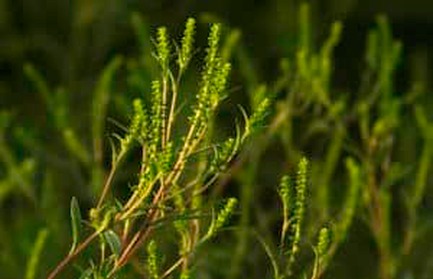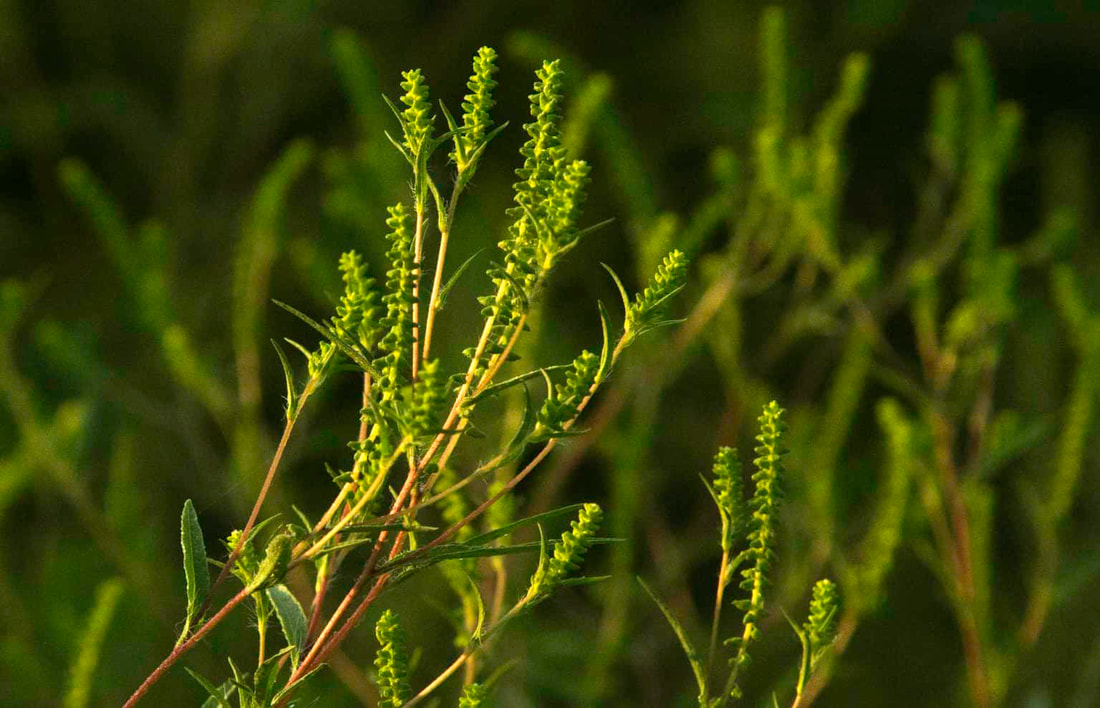Ragweed is a big bonus for gamebirds, songbirds, and deer tooBy KELLY BOSTIAN
For the CCOF The peak of hay fever season is upon us and if that has your sinuses aching for knowledge and your eyes just itching to see something, anything, good about ragweed, look no further. Oklahoma’s landscapes commonly grow three of the 24 varieties of ragweed found across the United States. Each is valuable for wildlife and in the past has served Native Americans as a food source, medicinally and in ceremonies—and that ain’t hay. First, let’s blow away some misconceptions. While the term “hay fever” persists, ragweed is not a kind of grass or “hay.” It is a member of a large genus of woody-stemmed forbs called Ambrosias, which are more closely related to plants like asters and sunflowers. Hay fever?“ Hay fever” is a term that dates back to the early 1800s, before people understood allergens and people associated the common malady with summer crops and fall harvest. These days we know it’s all about airborne pollens and an allergic response that can result in the cold-like symptoms that come with allergic rhinitis. Ragweed varieties spread their pollen in a manner similar to some trees and grasses and disperse tiny pollen grains that float on the wind for miles. One plant produces up to one billion. The peak of ragweed allergen season falls right around Sept. 10 in Oklahoma, according to the University of Tulsa Aerobiology Lab. Still, the bright yellow blooms of goldenrod that often line field edges and rural roadside sometimes draw blame for autumn allergies. They are just a showy victim of misplaced ire, however. Flowers are showy to attract pollinators like bees and butterflies that spread their typically larger and sticky grains of pollen. If you see a large butterfly on ragweed it is most likely just taking advantage of the sturdy plant to collect some morning dew or perhaps use the taller weed as a place to rest or to dry its wings. Ragweeds are hosts to a select few butterfly species that lay eggs on them, but the tiny flowers attract very few large pollinators. Honeybees do make use of ragweed pollen, however. Valuable browse and cover The Oklahoma State University Cooperative Extension Service recognizes the value of ragweed, even if its ragweed management report notes that the genus name Ambrosia, which means “food of the gods,” seems more to have come from the imagination of a quail hunter than a cattle rancher. Carl Linneaus in fact named the plant genus. Doubtless, many wish they could go back to the 18th Century and ask the scientific name system’s originator exactly what he was thinking in this particular case. Still, the Extension Service advisory leans against chemical control and favors monitored grazing as it notes a Nobel Foundation study shows it has higher nutrition levels than ranchers might think. “It is the number one food source for quail,” said Tell Judkins, upland game biologist for the Oklahoma Department of Wildlife Conservation. Ragweed is a good browse for deer in spring and summer. High-protein seeds stay on the plant well into winter, which makes it ideal for migrating or over-wintering birds, as well as native quail, and turkey. Giant ragweed, which may grow up to 10 feet tall, provides loafing cover for birds to avoid predators. Bugs and roots Ragweed also attracts a variety of insects that birds like to eat, from grasshoppers to fluid-sucking bugs. The different species are host plants for a variety of moths and a few butterflies—which means caterpillars for growing birds in summer and for migrating birds in autumn. Enough birds visit some ragweed stands to draw in moths associated with bird droppings, according to the Missouri Department of Conservation. With root systems that stretch 5 to 6 feet deep, ragweed also is among a variety of lowland plants that help protect waterways from excessive erosion, and as a filter to stop excessive silt, fertilizers, or pesticides. “It is a highly misunderstood plant. It makes us sneeze but it is important for quail, and it produces a lot of seed they’re able to reach for a long time and it will form in dense stands that are escape cover,” Judkins said. Kelly Bostian is an independent journalist writing for The Conservation Coalition of Oklahoma Foundation, a 501c3 non-profit dedicated to education and outreach on conservation issues facing Oklahomans. To learn more about what we do and to support Kelly’s work, see the About the CCOF page.
0 Comments
Leave a Reply. |
Archives
May 2024
Categories
All
|
Conservation Coalition of Oklahoma
P.O. Box 2751
Oklahoma City, OK 73101
[email protected]



